Shipley Glen Tramway, Shipley
TODAY'S ITINERARY
Exploration: Sunday, 23 June, 2019
lv London Kings Cross 0903 London North Eastern Railway
ar Leeds 1126
lv Leeds 1216 Northern
ar Saltaire 1230
lv Saltaire 1537 Northern
ar Leeds 1554
lv Leeds 1616 London North Eastern Railway
ar London Kings Cross 1828
Kings Cross again. Just a few months before my trip the London North Eastern Railway began using their newly acquired trains called Azuma. As marketing the railway had big posters up in Kings Cross showing what the trains look like, and a special line on the departure board to let us know that the train to Leeds, platform not yet announced, would be made up of Azuma equipment. A stroll from the new hall into the old arched portion of the station led me to precisely one train that matched the picture, so I azumed that it was the Leeds train. I thought it would be polite not to walk down the platform before it was announced. After a dozen or more other people walked out and were able to open the doors, I went for it and found myself a comfortable window seat. We sped north, and somewhere we branched off the main line and continued on to our destination.
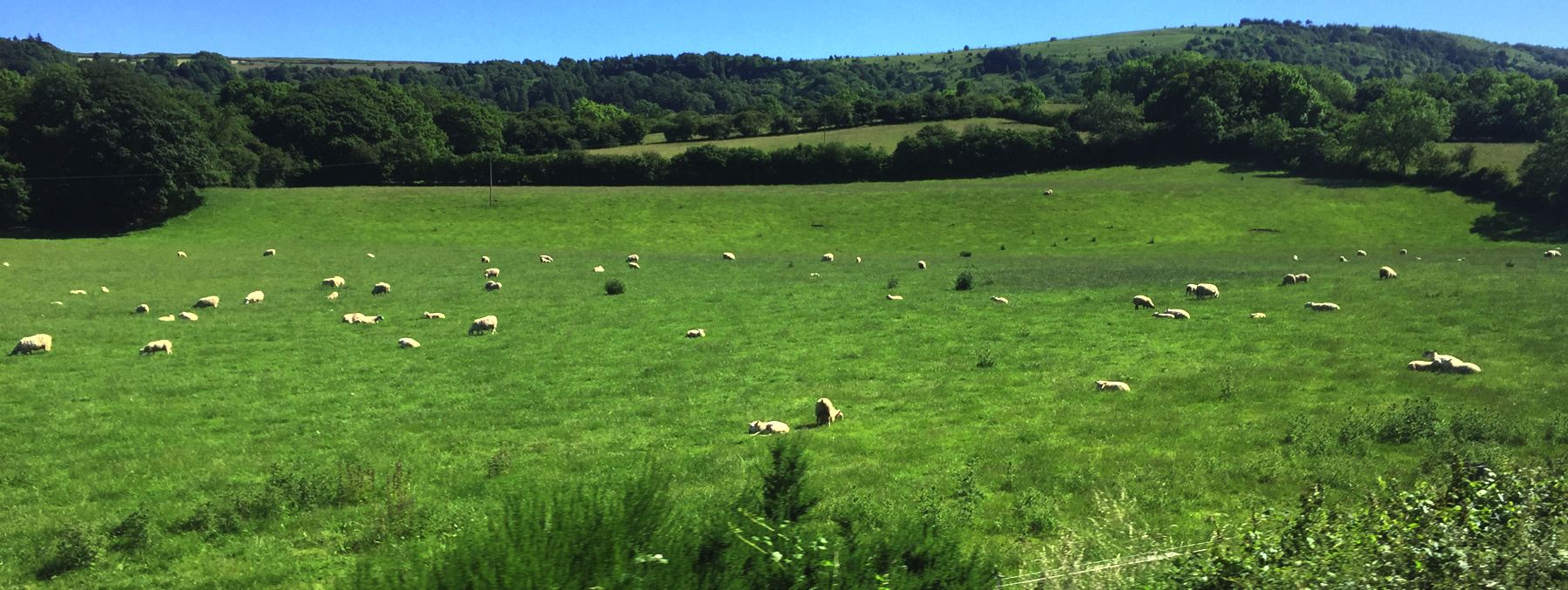
The National Sheep Association puts the sheep population of the United Kingdom at 33 million. I saw many of them.
I was leaving so late because the Shipley Glen Tramway does not start service until noon. Although it is not inside a paid area and anyone can walk up and use it—my requirement for this set of pages—it was quite clear that usage is almost entirely tourist.
The connection at Leeds was not a close one, and that was fine because I wanted the opportunity to take a look around. I have never set foot in the city, one of the most important in northern England. The station itself was under construction so it did not look its best. I went out to the streets.
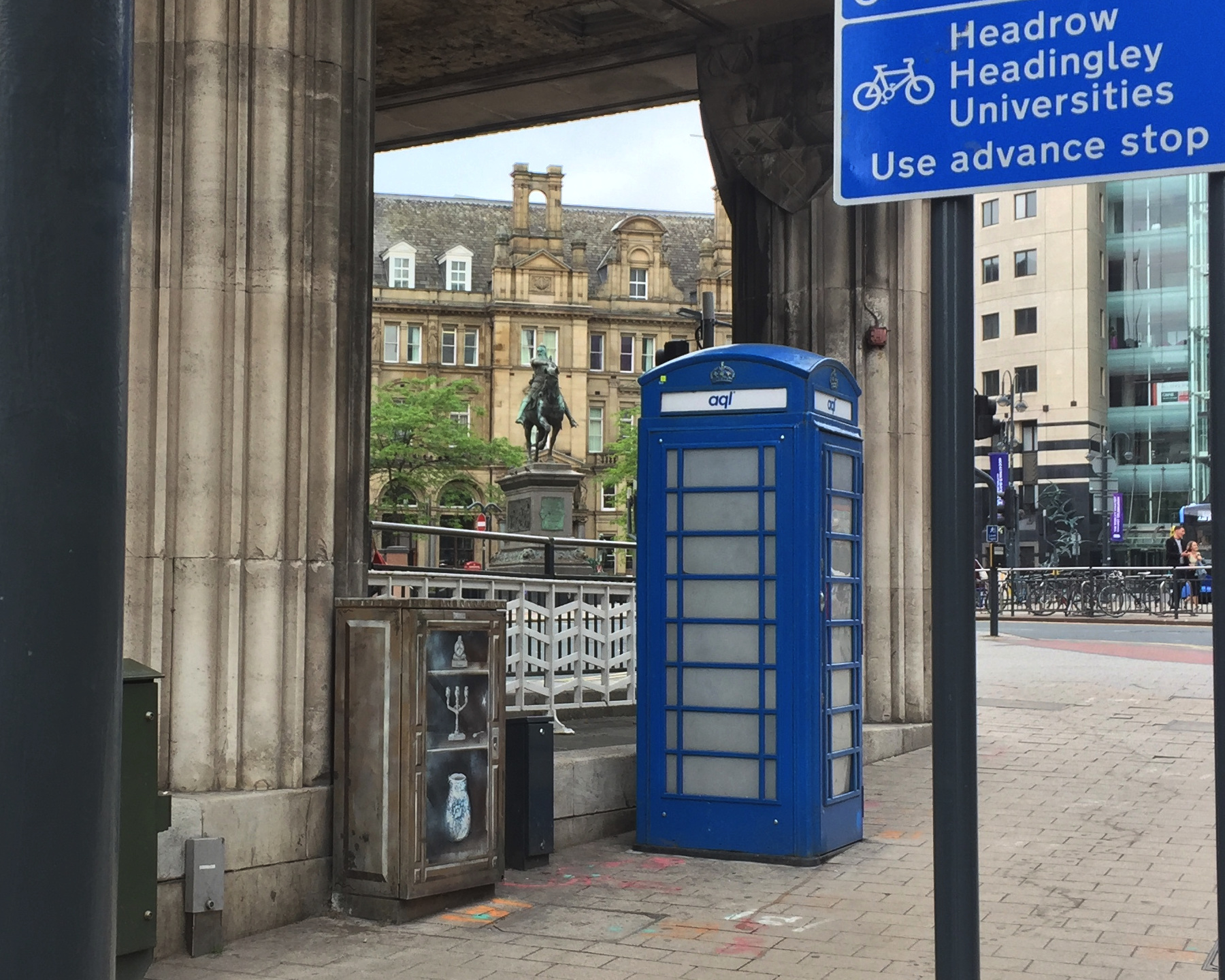
This is what I saw, coming away from the station, where every path directed me to the northwest side, toward the city center. Sometimes I see things in a photograph that I did not see in real life, like that cabinet at the base of the fluted column, with the painted antiques, that seems to be leaking sidewalk chalk. What is that about? As for the phone box painted blue and bearing the letters aql, like Benedick I noted it not, but looked upon it. By contrast I could hardly miss that noble equestrian statue back there. See it? I made my way across the traffic lanes to see which prominent Leedster that represented.
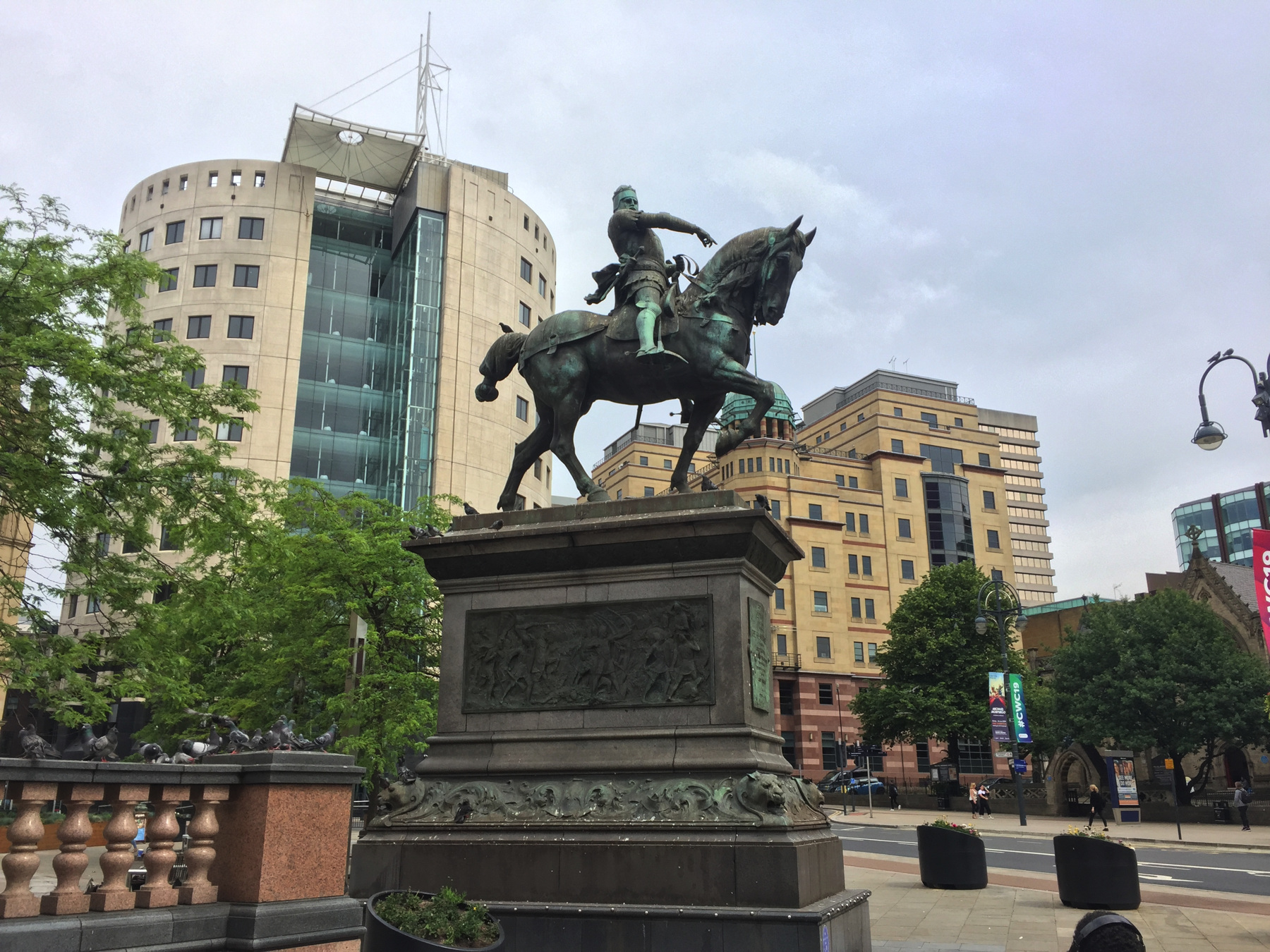
The inscription on the base of this inspiring bronze reads as follows. EDWARD ⋮ PRINCE OF WALES ⋮ SVRNAMED ⋮ THE BLACK PRINCE ⋮ THE HERO OF ⋮ CRECY AND POITIERS ⋮ THE FLOWER OF ENGLAND'S CHIVALRY ⋮ THE VPHOLDER OF⋮ THE RIGHTS OF THE PEOPLE ⋮ IN THE ⋮ GOOD PARLIAMENT ⋮ — ⋮ 1330 — 1376. The prince died before his father Edward III and so was never crowned king, but his leadership in the Hundred Years' War earned him England's praise. Yes yes, and what about Leeds?
This is embarrassing. No particular connection. When the work of art was placed here in 1903 the crowds were puzzled. "There was no figure with local associations heroic enough for the site", explained a reporter for the Yorkshire Post in 2014. What Loiner could we put on the horse if we could do it now... Melanie "Scary Spice" Brown is from Leeds... "Michael Jackson - writer and journalist, particularly on beer and whisky" but not so good when sober, implies Wikipedia... Peter O'Toole, ditto, from what I've heard... John Smeaton, "the father of civil engineering"... and Christopher Tolkien (what!). I have probably missed your favorite.
And so after this, I was off on a local train to Saltaire for the Shipley Glen Tramway. The tramway is within the town of Baildon, but in the post town of Shipley, and in the metropolitan borough called City of Bradford. I'm giving its location by the post code. It is not near the center of any of those named places, but rather the lower station of the tramway is an easy walk from Saltaire.
The name Saltaire may be misleading: it is not near salt air, but rather it is an inland model village founded in 1851 by Titus Salt on the River Aire. He relocated his several woolen mills here where he built many blocks of stone row houses for the workers as an improvement over their former living conditions. A factory town, but a good one, so good that the village remained nearly unchanged for decades, and when UNESCO designated it a World Heritage Site in 2001 that assured its continued existence.
Along the short railway journey from Leeds, the station called Shipley is worth a look from the train window. It has an unusual triangular configuration at the top of the Bradford branch. The direct trains from Leeds to Saltaire (and beyond) stop on the north side, the newest platforms. The other two sides are for trains to the city of Bradford from each direction.
And I arrived. As a World Heritage Site, Shipley has every right to be quaint. The first two below show the street alongside the railing of the railway station's open cut.
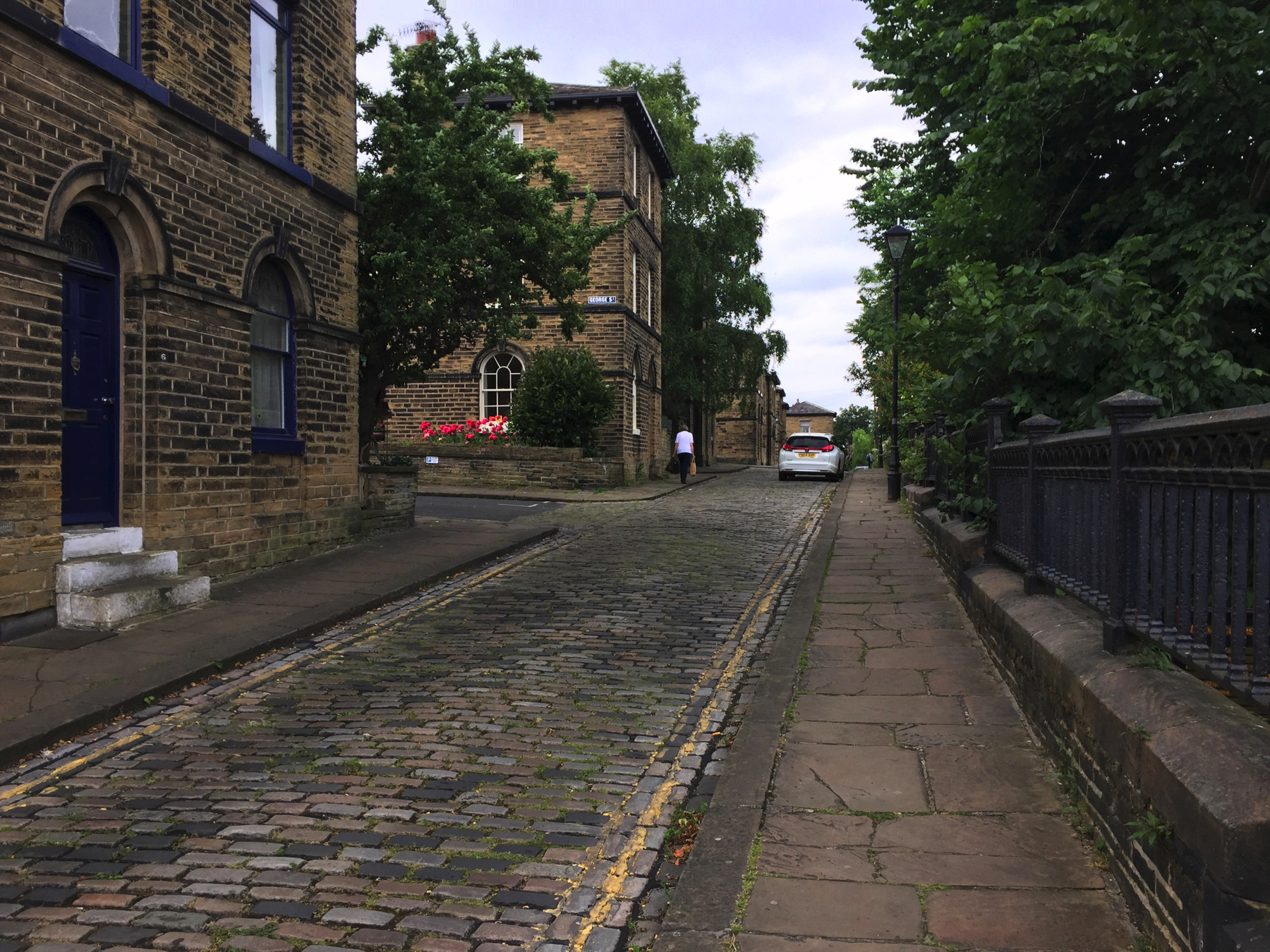
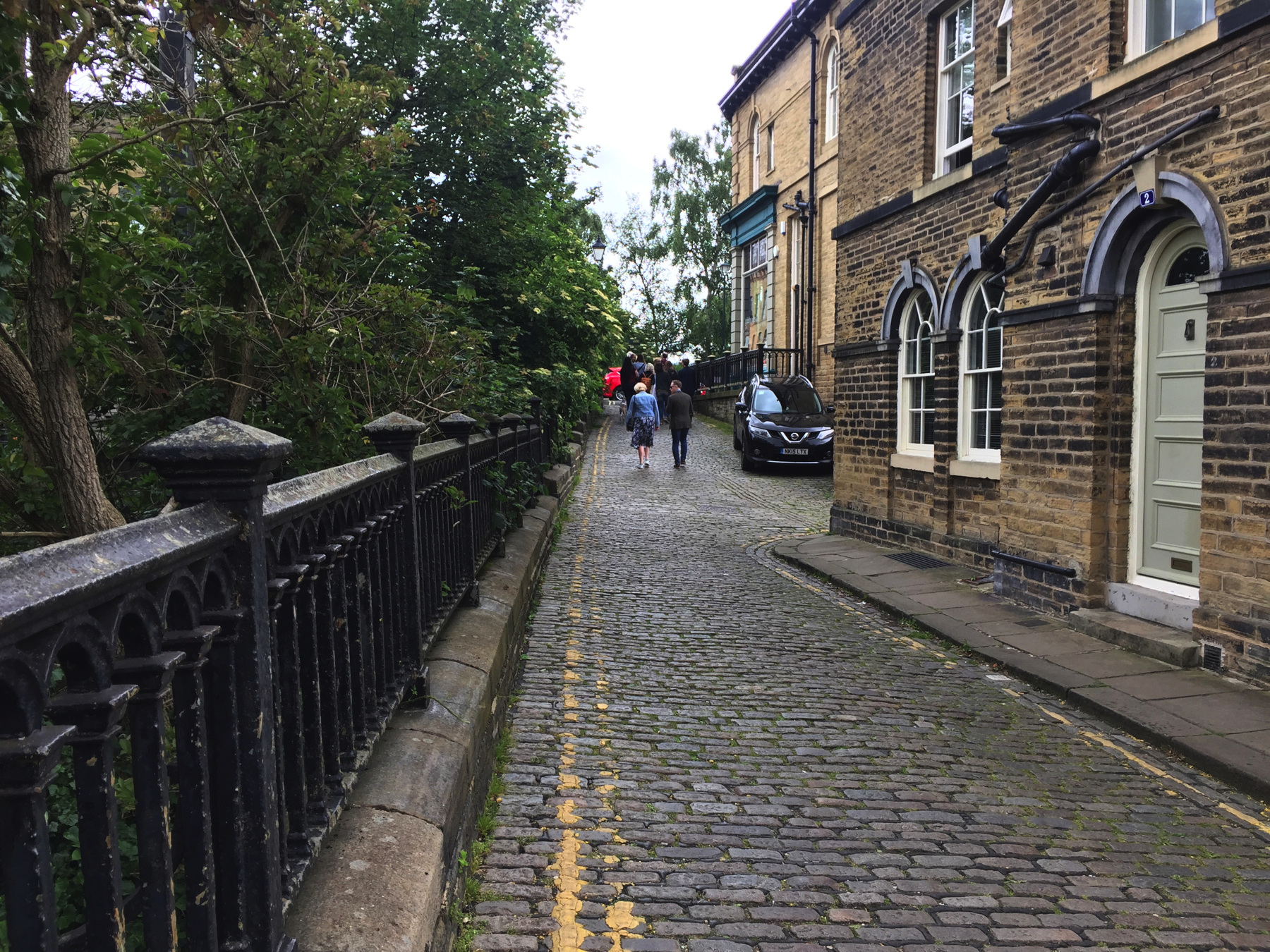
For the next view below I walked up the hill to the south and turned back to get a wider view of Saltaire and beyond it the ridge that the tramway ascends. There is no distant view of the tramway from any location because it is in the woods. At any rate its location is blocked by the buildings on the left side. Note the lions on each side—we'll come back to them later.
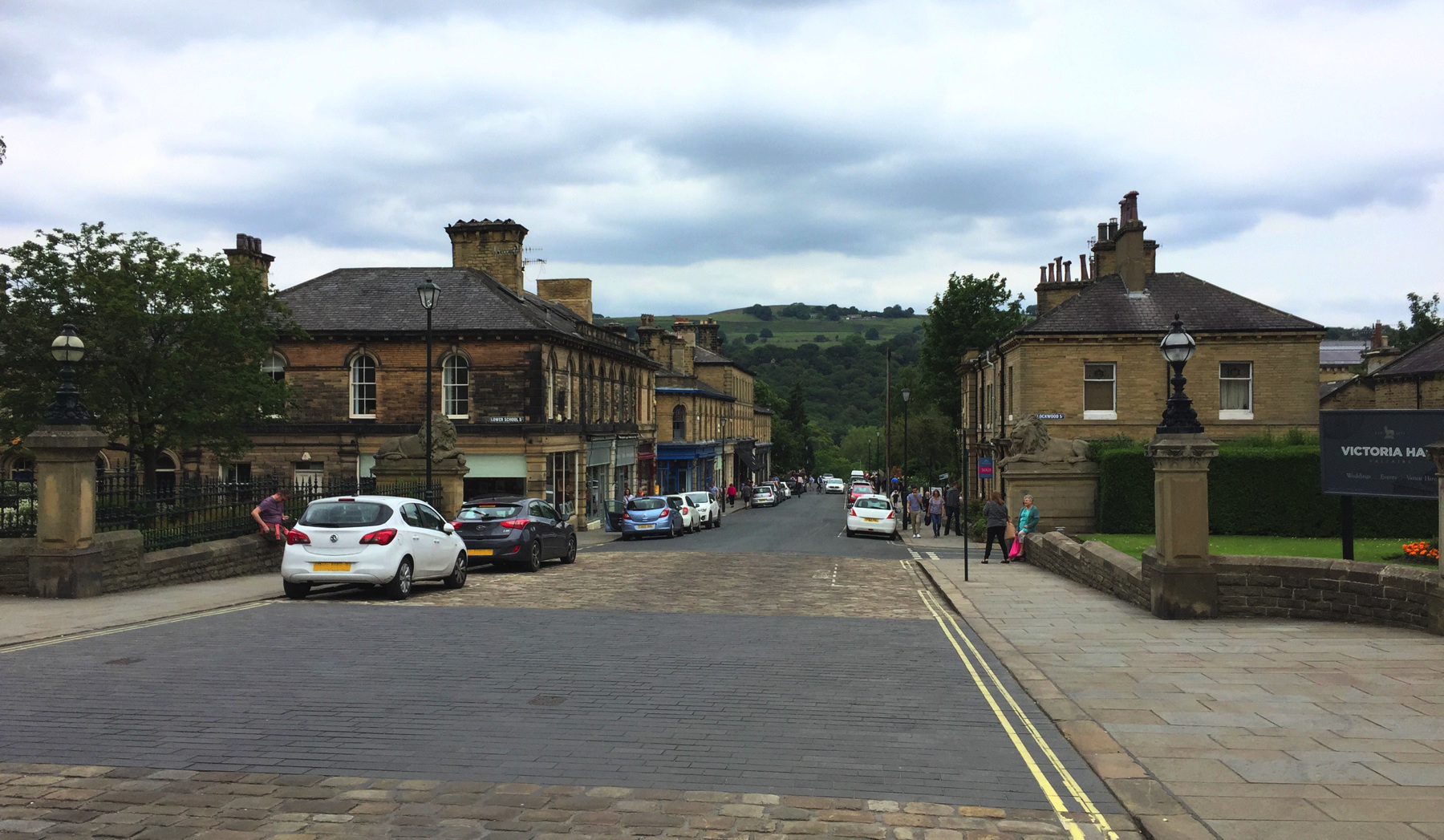
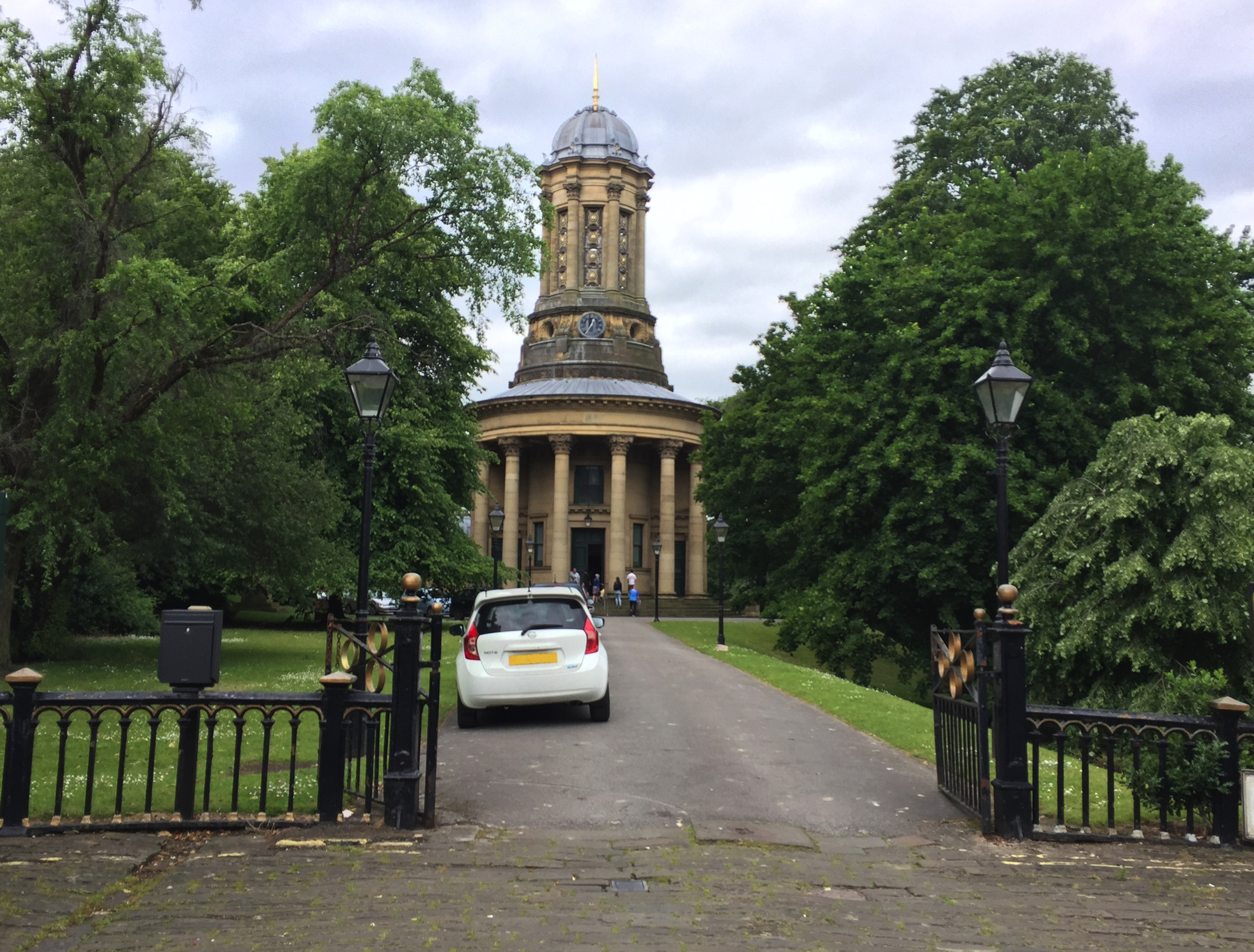
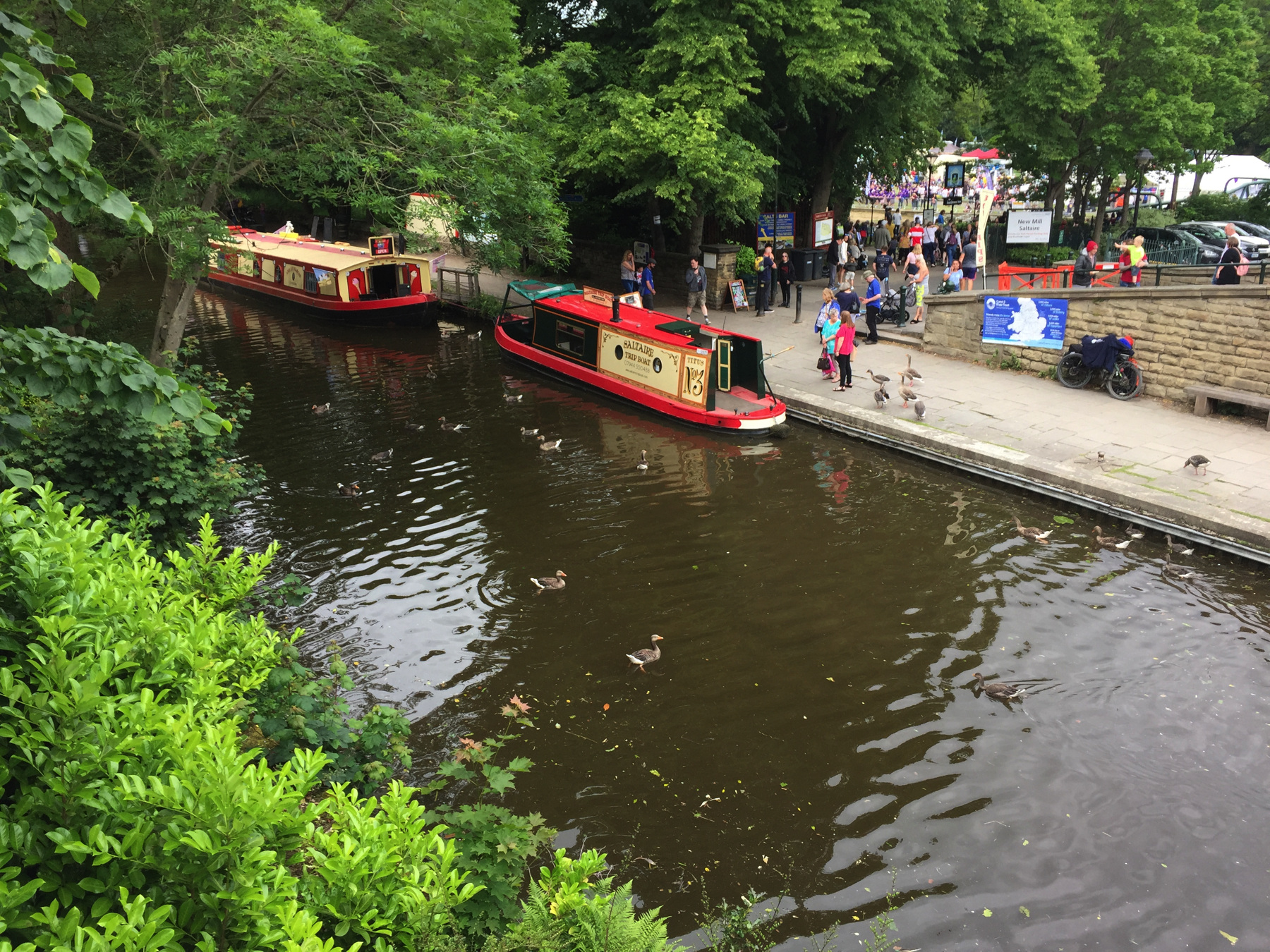
The Saltaire church, the first building Titus Salt commissioned for his town, is not in the middle of the blocks of houses as you might expect, but is rather between the station property and the canal, and across the street from the mill. The Leeds and Liverpool Canal is still open to navigation. Boat rides are available in the warm months. If you are walking from the station, you should pass the church on your left and the mill on your right, and then cross over the canal and the River Aire, and then continue across Roberts Park and go left at the road.
Then just follow the signs. You can't miss it.
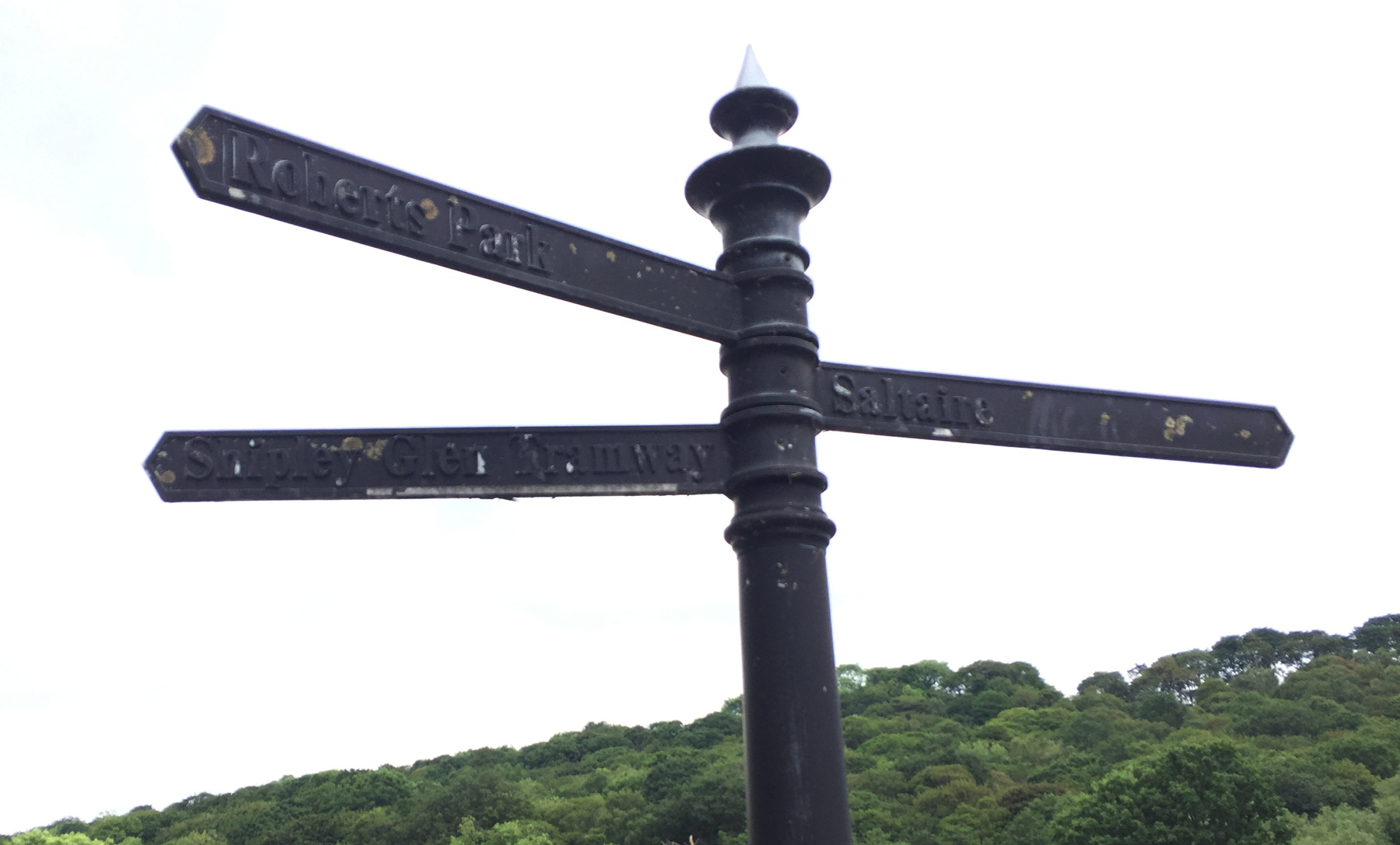
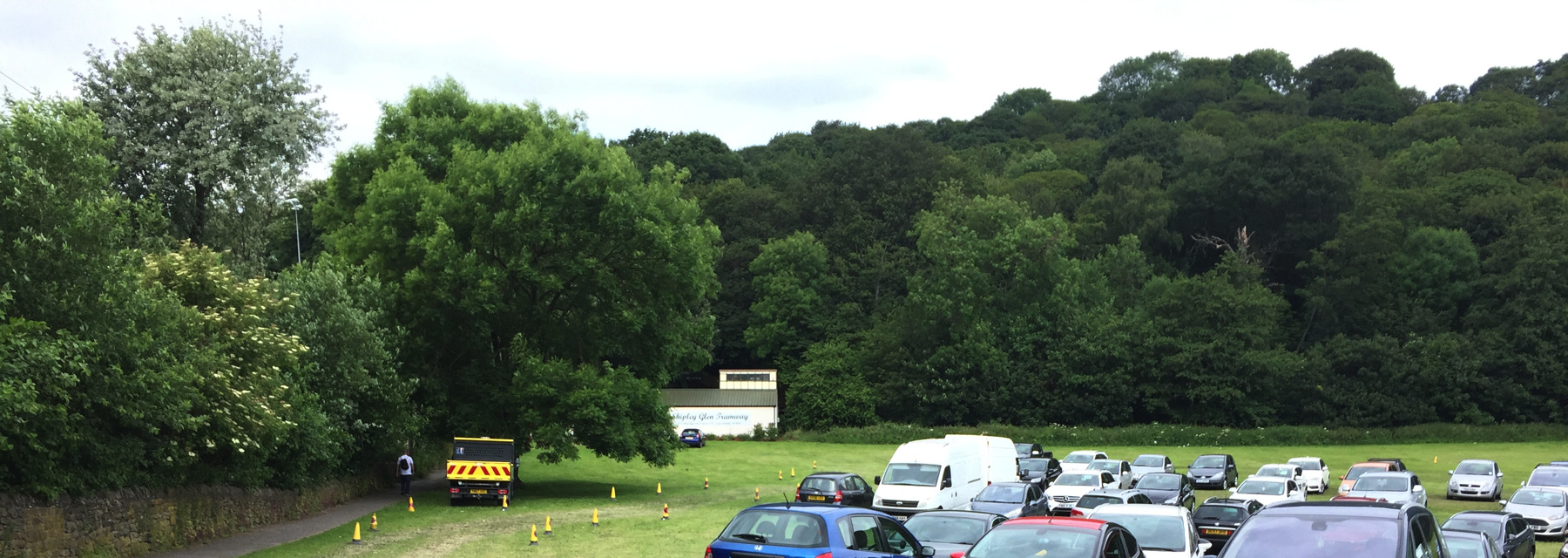
The sign on the lower station is pretty big. It needs to be. The bottom of the hill is way back there beyond the flat ground closer to the river that serves as a field of grass and sometimes as overflow parking for events.
The second picture below shows two things that I can explain only from memory because of an unfortunate turn of events.[note 1] I think the car shown is a re-creation of the original rolling stock, with reversible seat backs and one end higher than the other. The track shown was put in when there was an idea to extend the tramway down to the road, some year I do not recall, which was never done. Those curves could not have been done with cable so I wonder what the plan was.
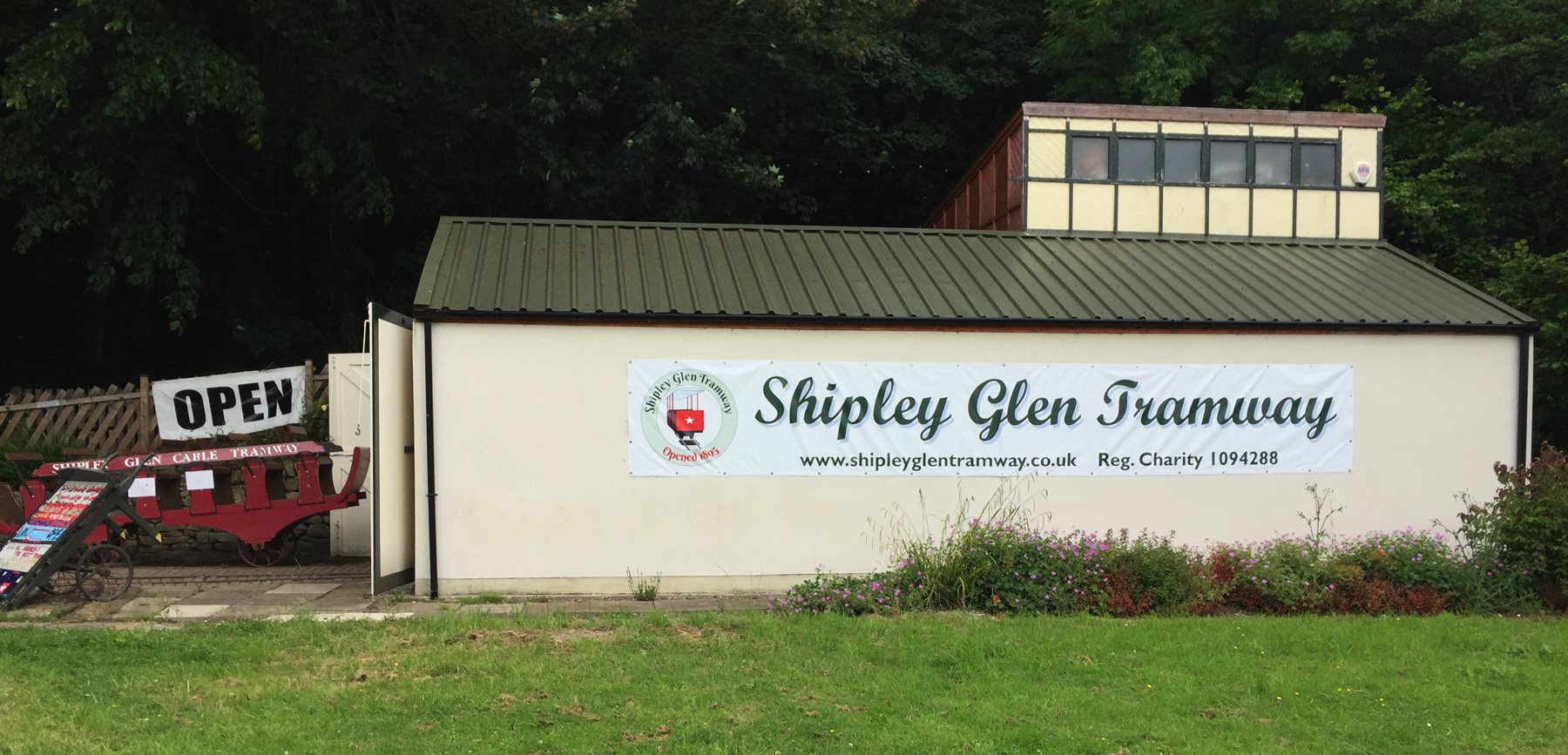
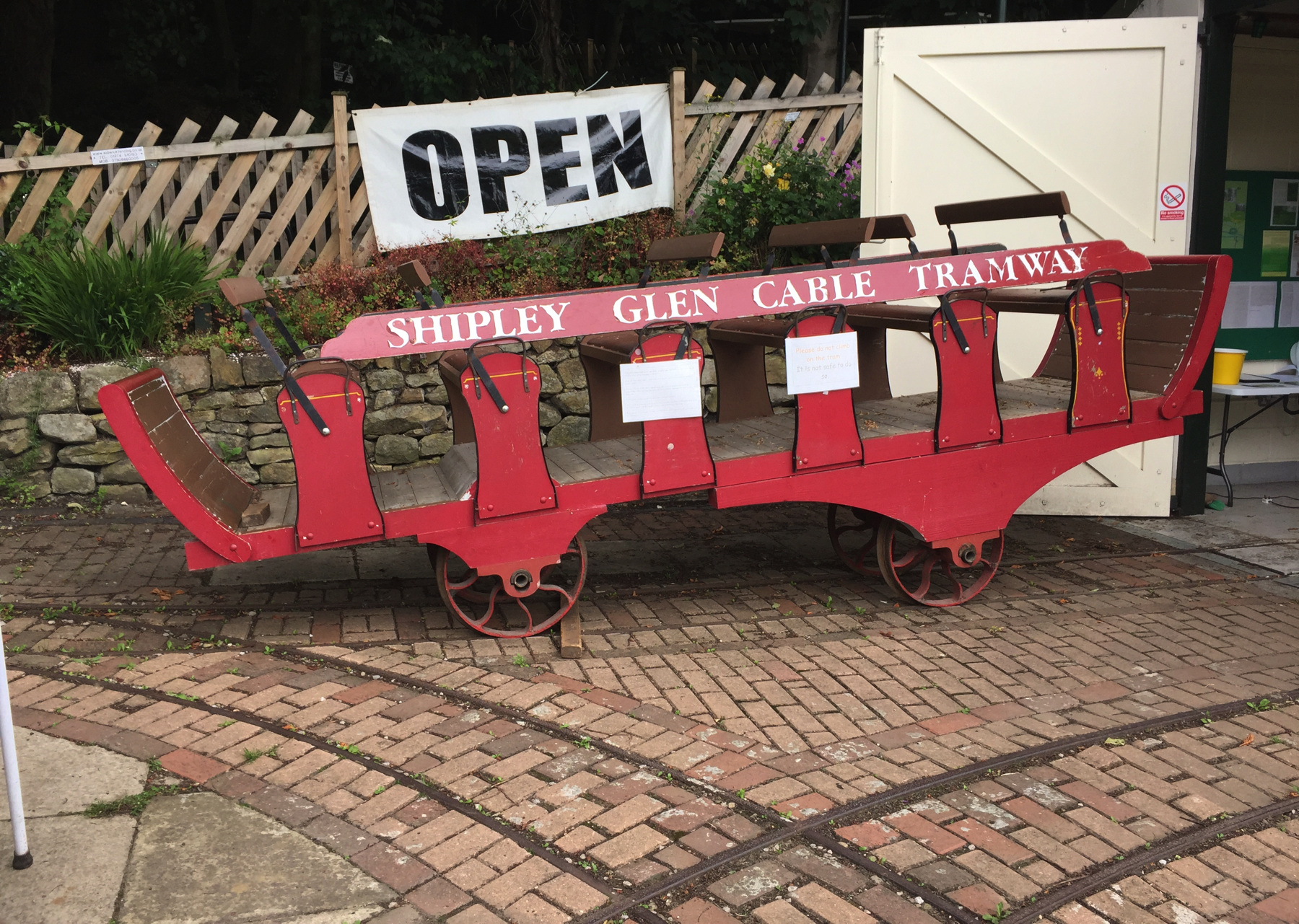
I went up on the red car with a few other people. I let the blue car go so that I could wait and get a picture of the red car without bothering anyone. The volunteers running the cars seemed to understand very well.
When we went up the blue car came down empty, an inevitable result of the funicular method. It was still early in the working day and if a car needs to go up, the other has to go down.
Let's take a ride.
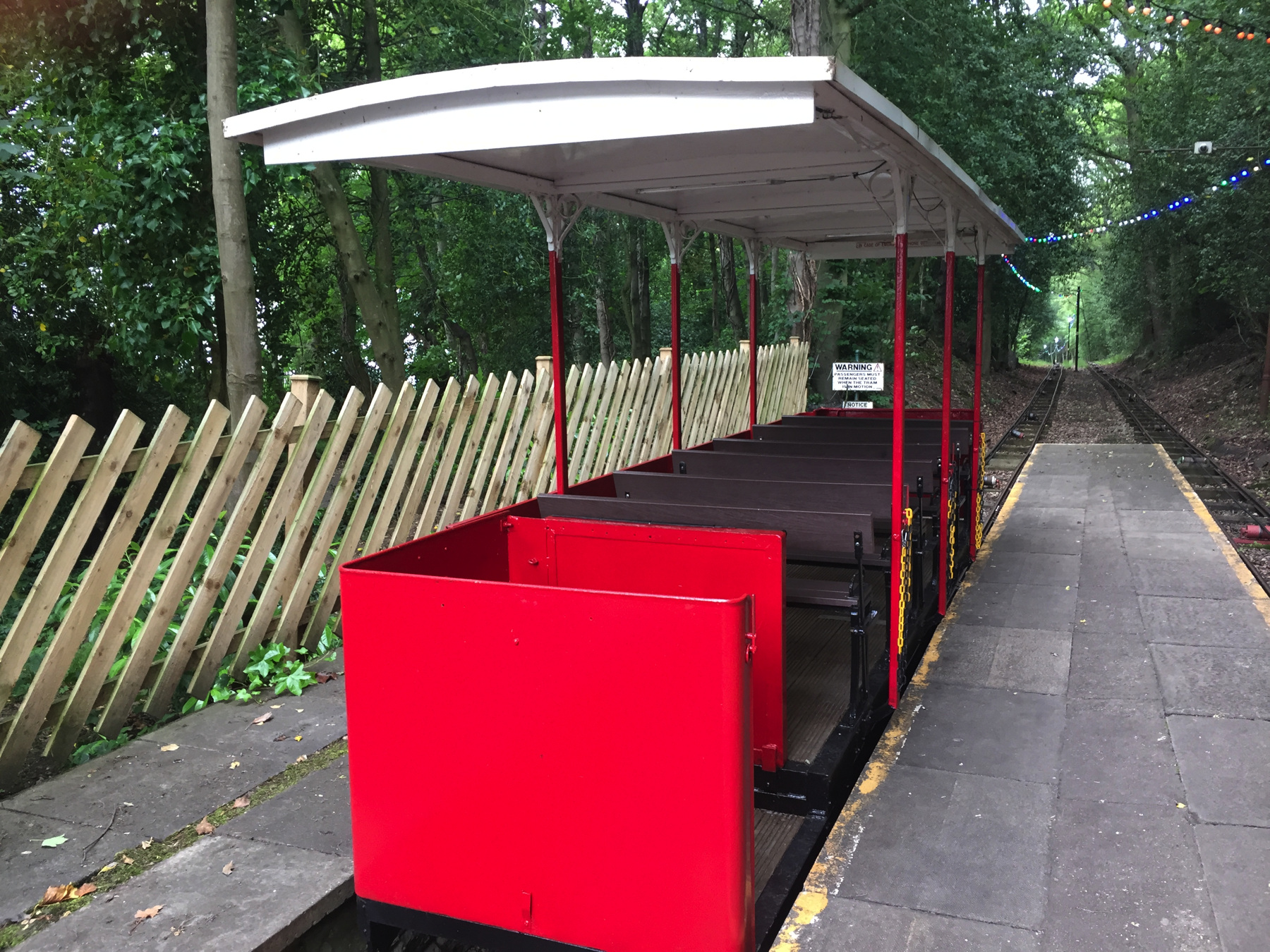
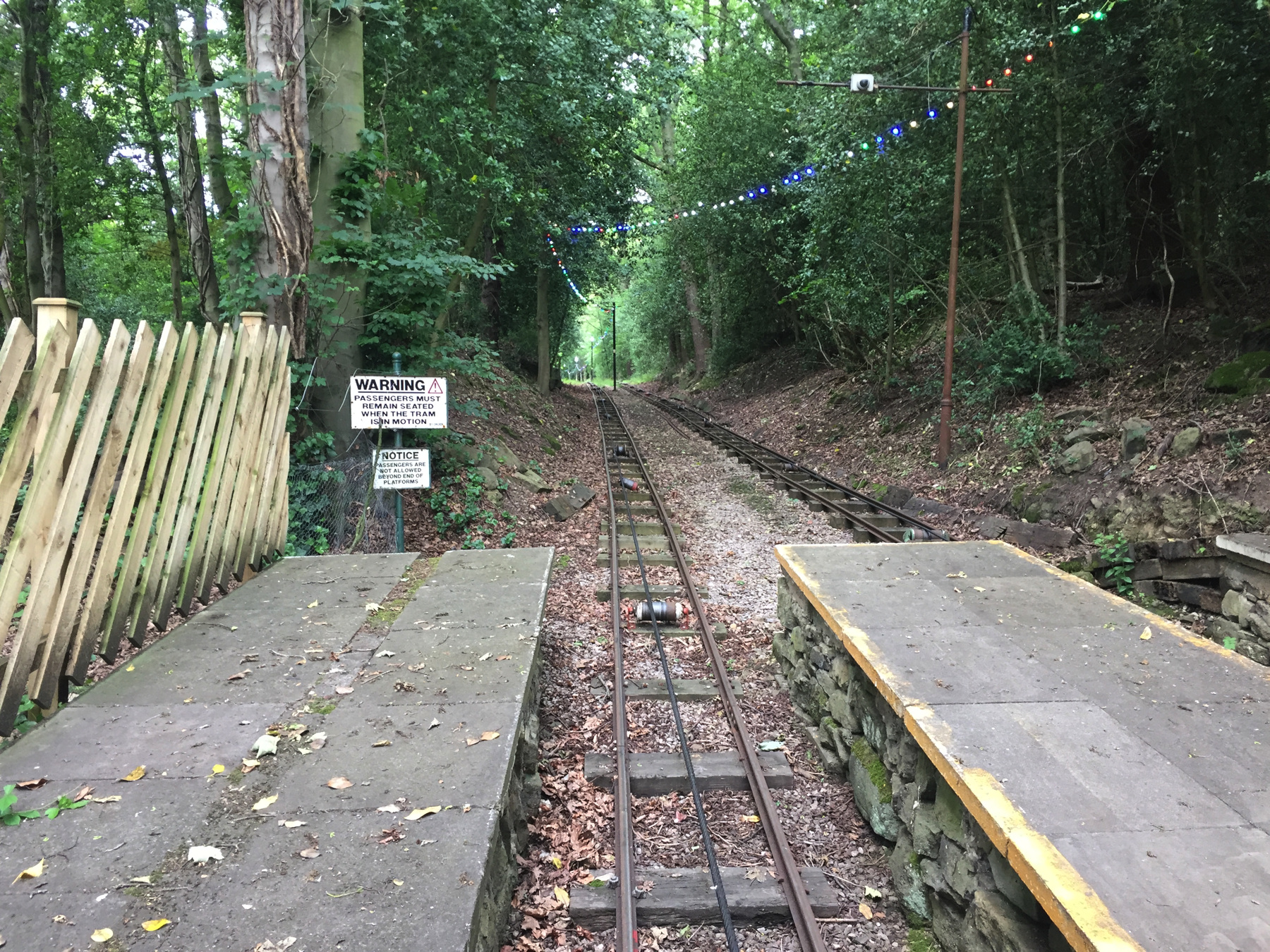
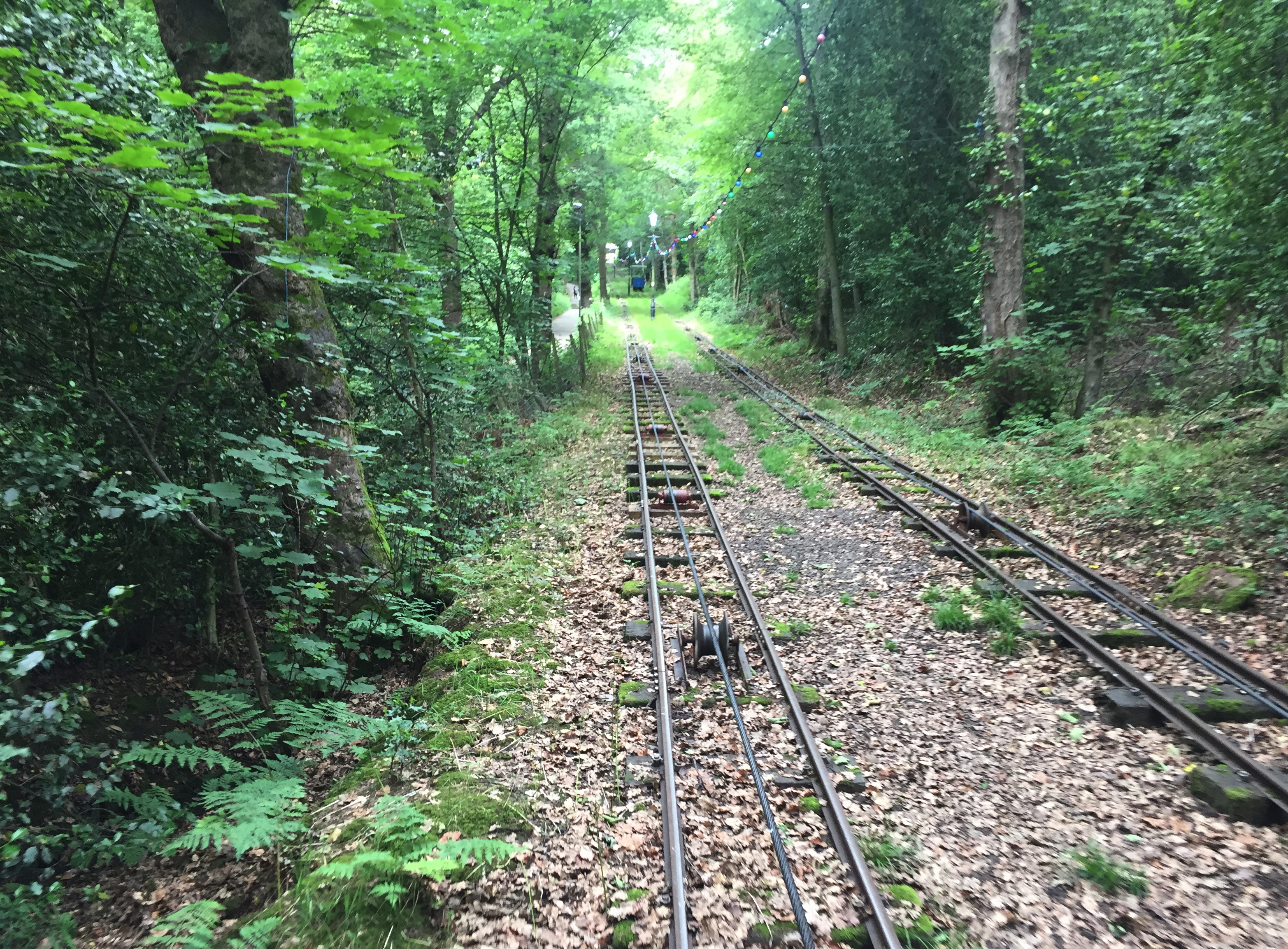
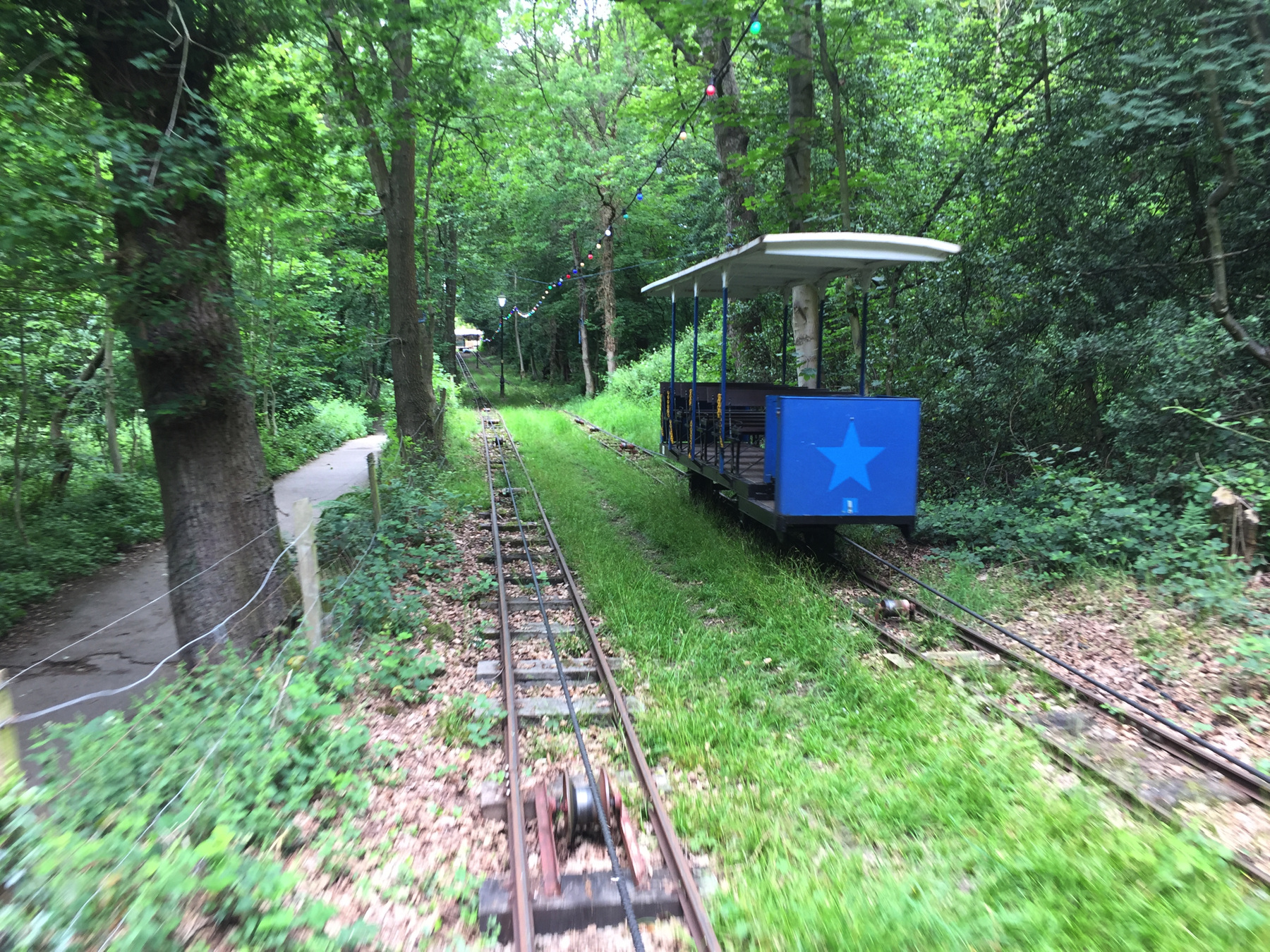
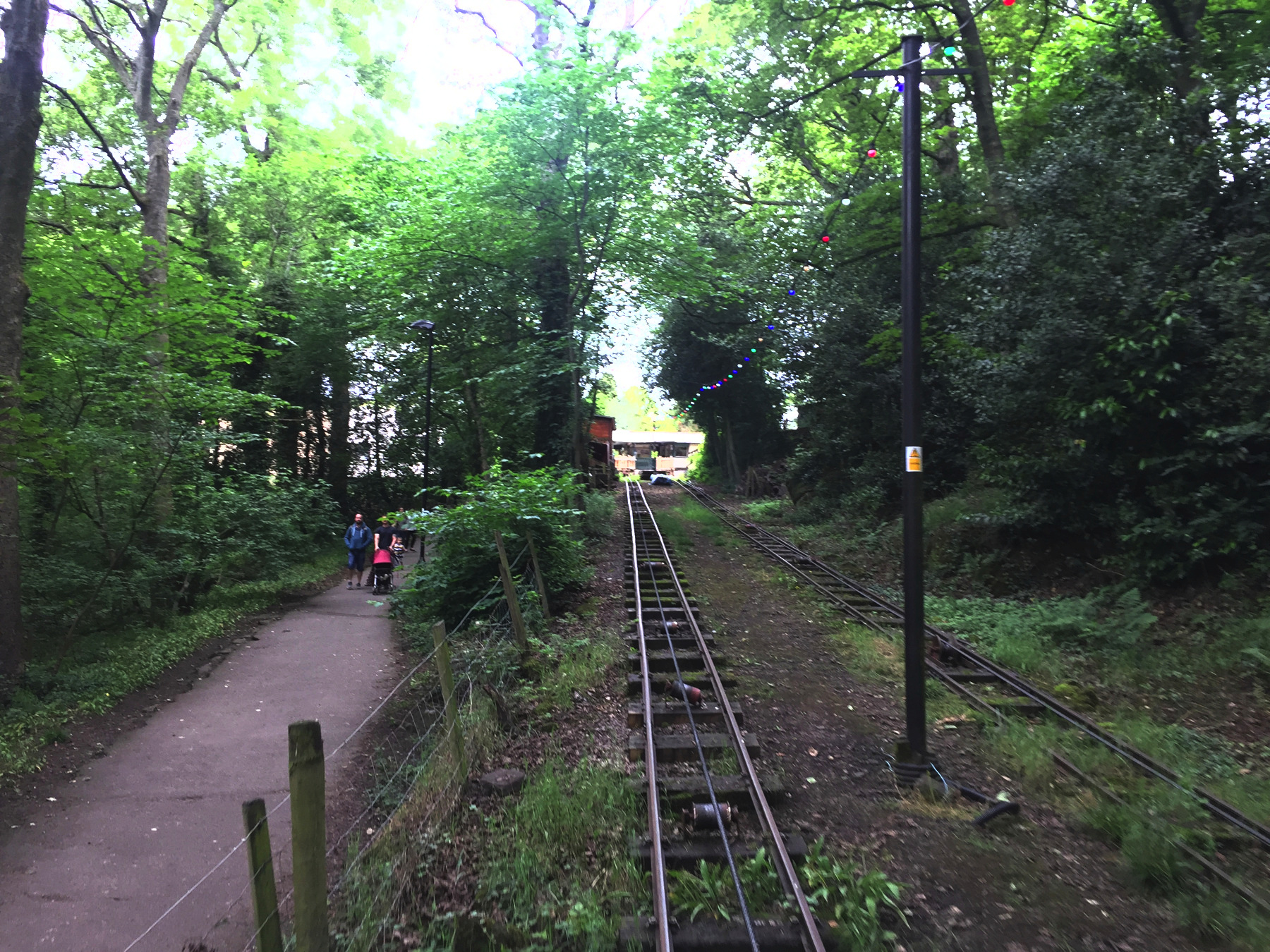
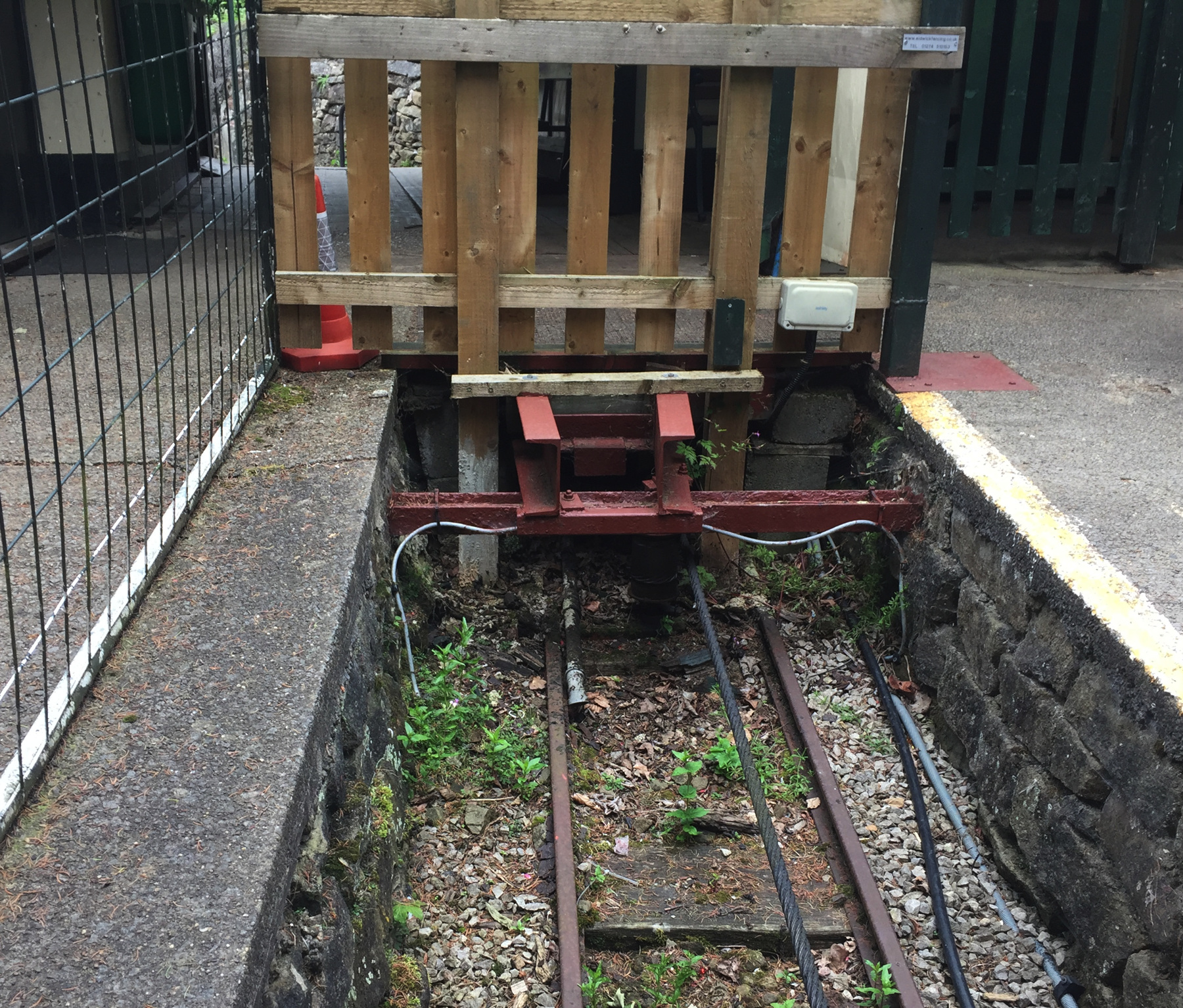
A single cable connects both the upper and lower ends of the cars. As usual the engine is at the upper station. All funiculars have to allow for the cable stretching over time. Some do it in the power house. The Shipley Glen Tramway does it at the lower end with a simple but effective method that is on view inside the lower station.
In the first photograph, at the top you can see the horizontal wheel around which the cable turns, mounted on a green frame, with a chain pulling it back. The red pulley is in both photographs. In the second one you can see that the chain runs to a hook that holds up a weight of blocks and old steel. The green frame is almost at the end of its track and the weight is just inches off the floor. Eventually the cable has to be shortened or replaced.

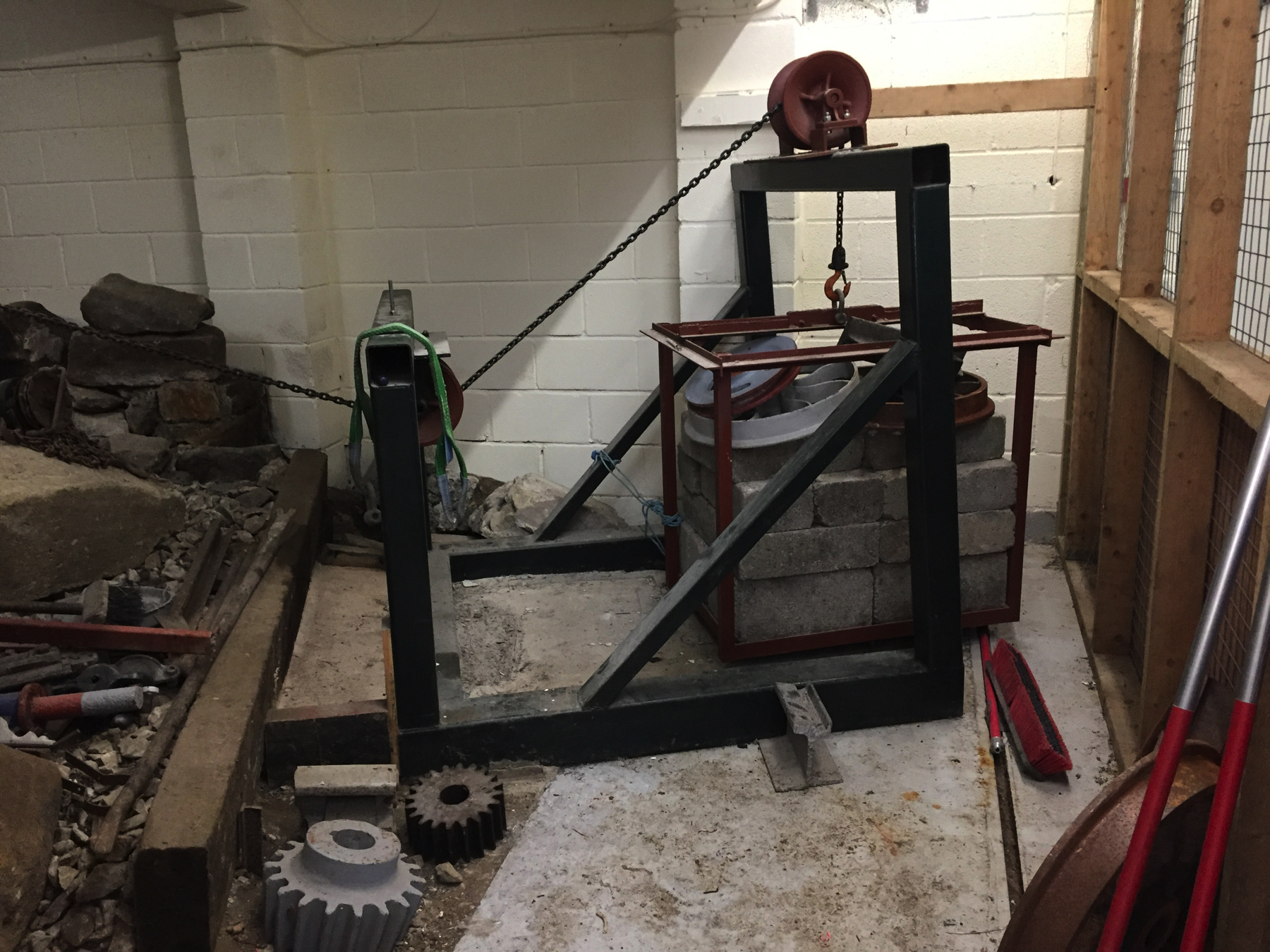
Both stations are relatively modern replacements, but outside the upper station is what appears to be an old overhead sign with a variant of the name, Shipley Glen Cable Tramway—the lower station sign omits "Cable". The upper station is tucked away in the landscape as much as the lower. The portable sign on the right alerts anyone passing by that the thing in the picture is open. A public footpath sign points the way to walk along near the hill crest.
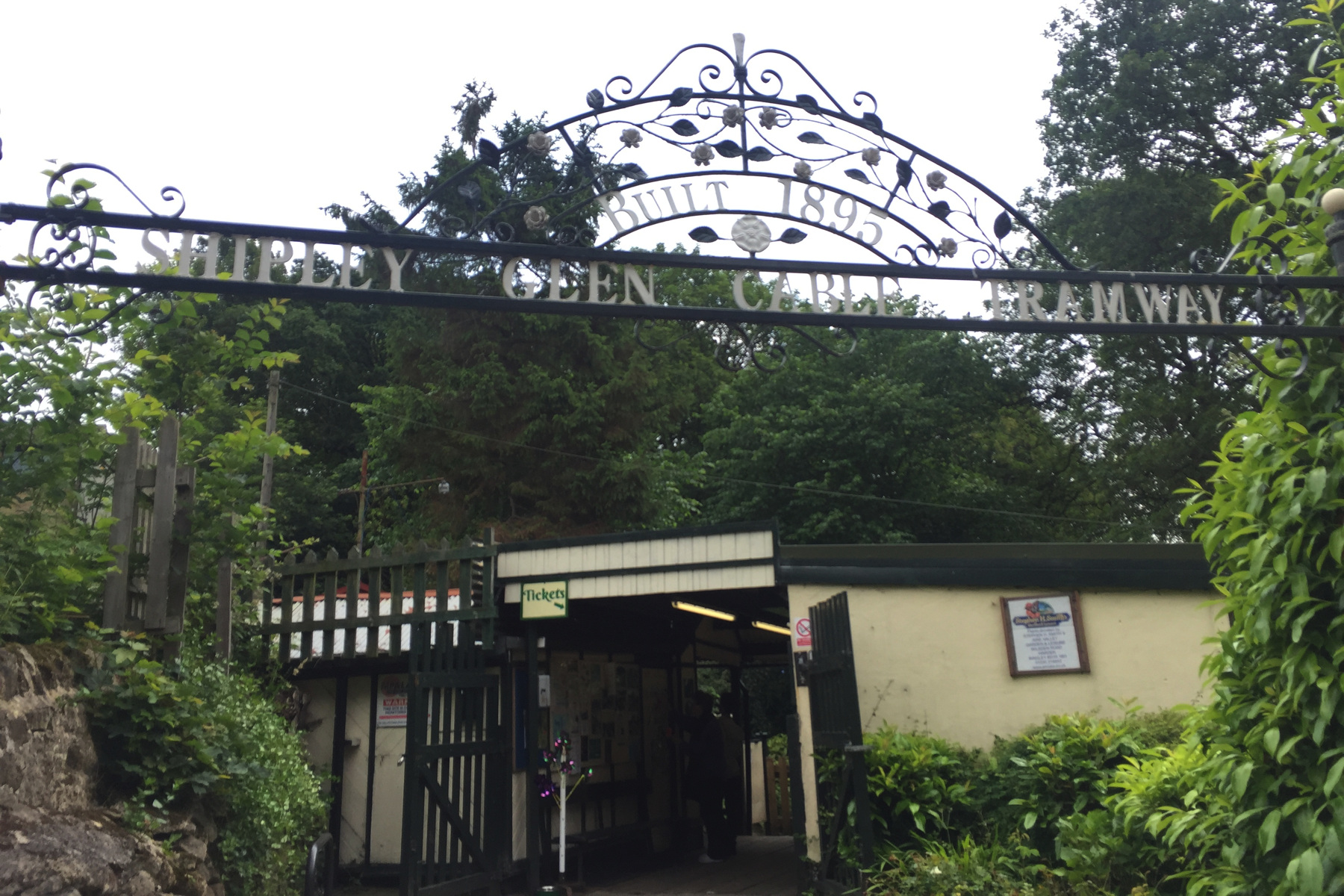
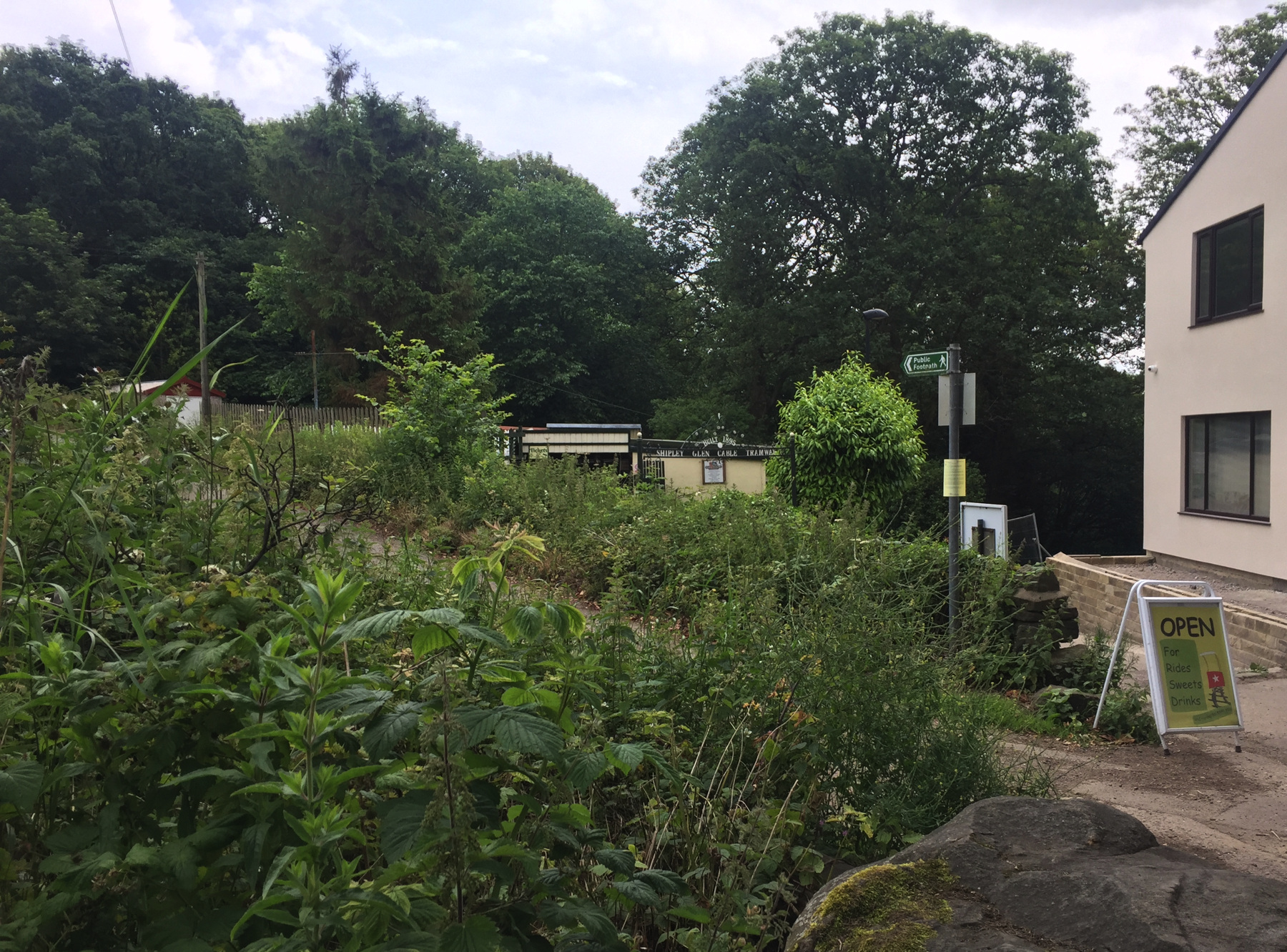
The scenic location of the tramway is not Shipley Glen. The tramway runs up through Walker Wood to its terminal at the end of Prod Lane, along which people once walked no more than half a mile past a collection of amusements that included a "circular railway" at the Old Glen House and a little farther on a "switchback railway" at Bracken Hall. The two places are now a good pub and a museum respectively. It is only opposite Bracken Hall that you can cross a field of "catten stones" and go down cliffs into Shipley Glen. The stones are flat on the ground and may have slid by gravity to their present positions, but under that name and Soldiers Trench they are said to have been assembled in patterns by the people of thousands of years ago. Among them is a flat stone circle that was reportedly "improved" in Victorian times! All the attractions on the hill top, referred to collectively as Shipley Glen, were the destination of the Shipley Glen Tramway.
Back down in Saltaire I wanted to get some photos of those lions in the square between the Salt Building (originally the Factory School) and the Victoria Hall. Signed with "T Milnes Sculp London", they bear the names DETERMINATION, VIGILANCE, WAR, and PEACE. Thomas Milnes designed them for the base of Lord Nelson's column in Trafalgar Square but he did not get the commission. Titus Salt saw the models in Milnes's workshop and requested they be carved of local stone for installation at Saltaire. The names do seem more appropriate for the original site than a school for millworkers' children, but rah rah the British Empire. When grown the children would be sent to do the fighting.
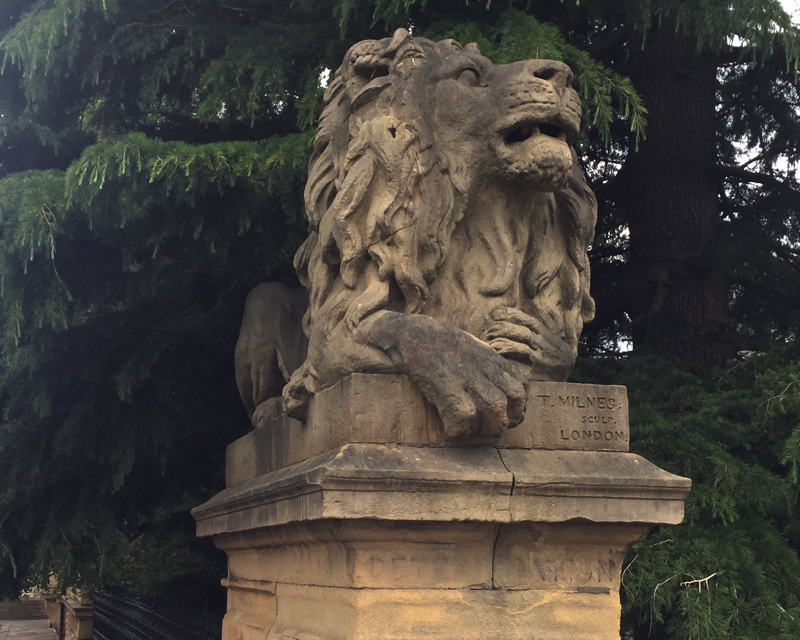
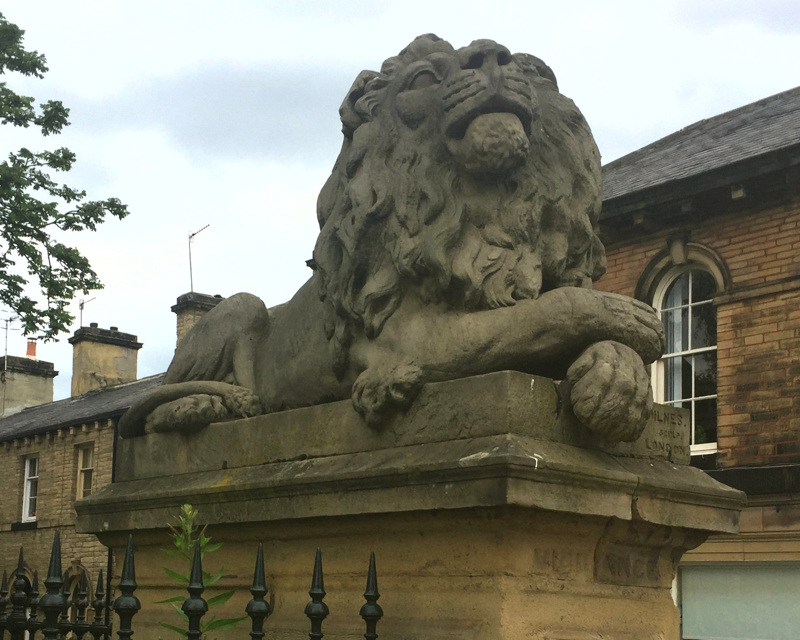
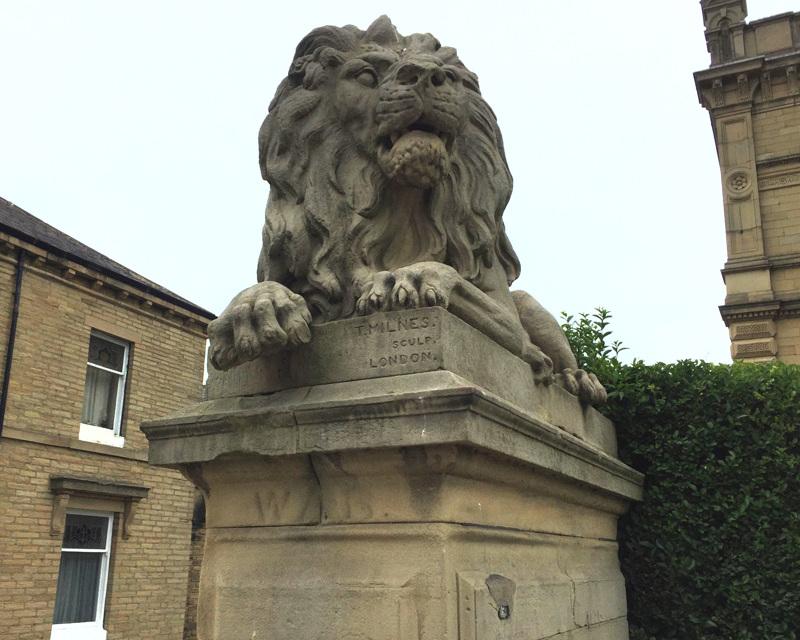
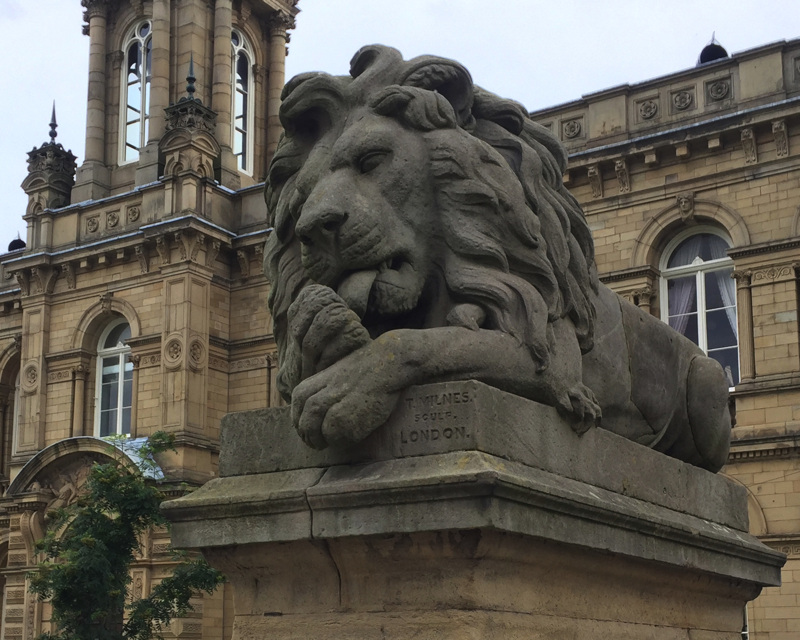
I returned the way I came. In reverse of course, but the way I came.
[note 1] The events at Leeds station may stand as a lesson, and for that reason and that reason alone I will relate the story as it happened to me. In the upper station of the tramway I had purchased two booklets about it, using an American credit card. I had to explain that I could not tap it because not all of us in America have cards fully up to modern technology, getting a laugh from the two shop women. We tried swiping it instead and to our wonder it was accepted. These two thin publications I had in one hand as I used the other to grab the bar to safely detrain at Leeds. Every station in Britain seems to have high platforms—a wonder to this American's eyes, who has four steps difference at his home station—and yet the heights of the platform and the train floor never seem to match. As I stepped off an elderly woman was trying to get on the train with... I don't know what it is called in Britain. I can't even think of an unambiguous word in my native lingo. It's the metal basket-like toter thing with one axle that you put your packages in after shopping so you can shlep them home. Whatever it was, she had a heavy load of things in it and needed to pull it up the damned step into the train. I decided to be an excellent person and lift it for her, which she appreciated, and so I tucked the booklets under my arm and lifted the cart laden with stone pavers packaged in brown paper up and onto the floor of the train. And as I relaxed from my labor the two booklets slipped easily from under my arm and directly into the space between the train and the platform. I considered approaching the staff about waiting for the train to go out, at which time an appropriate person could jump down and get them for me, and I considered going back to buy new copies, and then at last I considered that I am already in possession of a sufficient number of booklets about destinations I will never see again. And with that thought I smiled and walked away, a fraction of a pound (weight) lighter and a few pounds (money) lighter. The booklets had given me joy during the time I was given to read them at Saltaire station. The lesson is to ask the elderly person to hold the booklets for you while you lift their elephant, or alternatively the lesson is not to buy booklets you could live without.